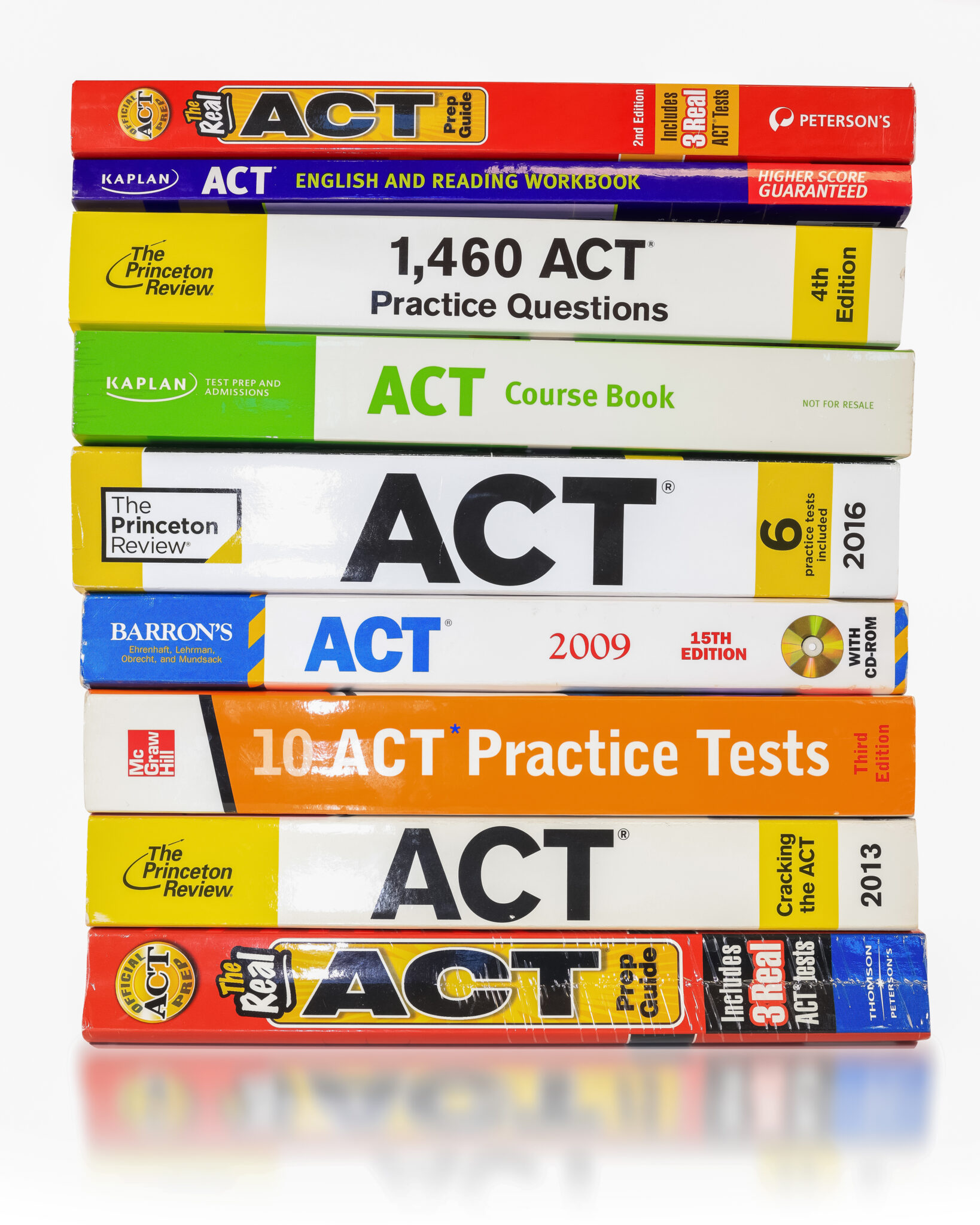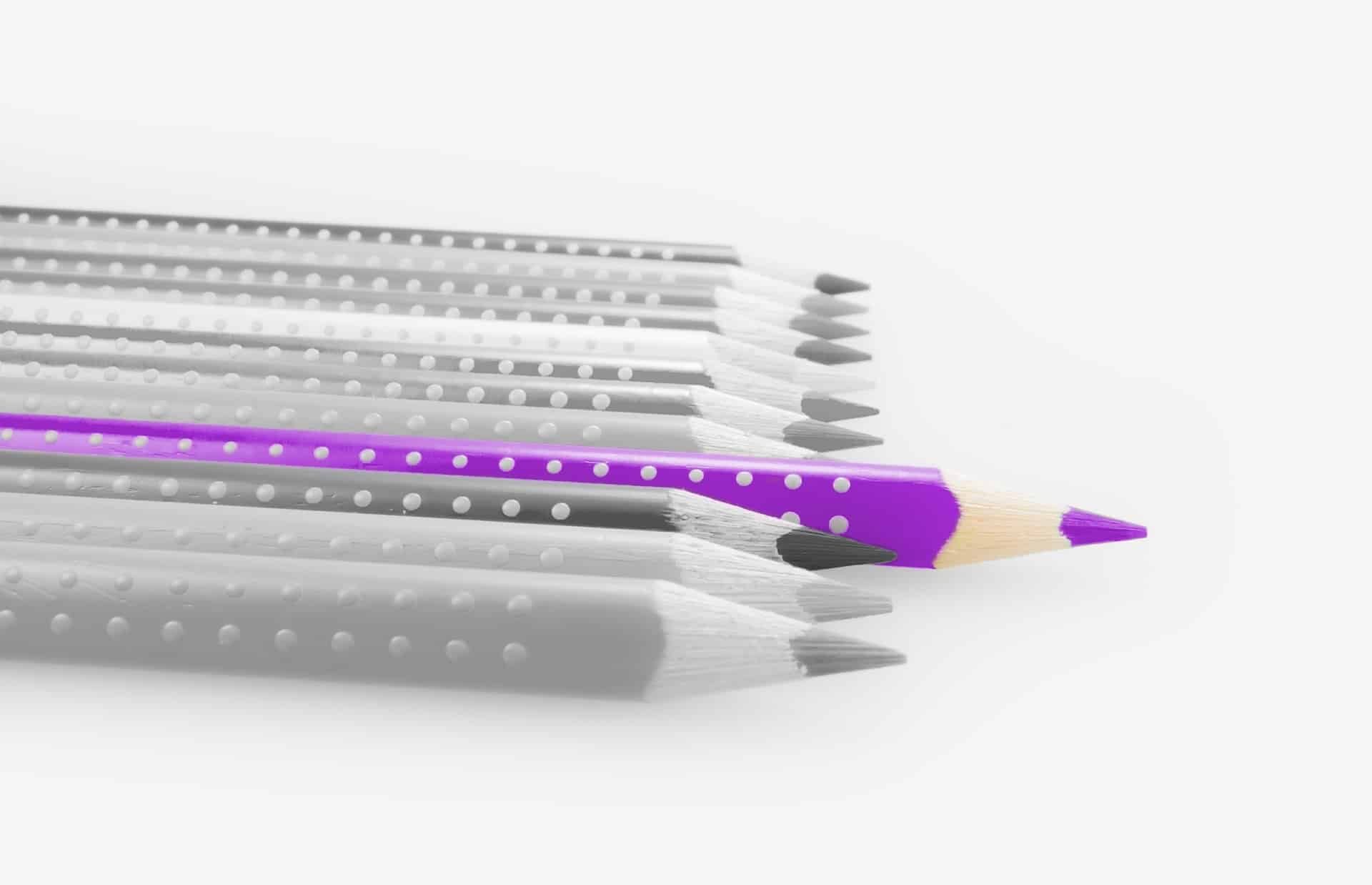Performance assessment and product assessment are central in assessing the growth in learning for all students, including those with gifts and talents. The National Association for Gifted Children (NAGC, 2019) Pre-K–Grade 12 Gifted Programming Standards state, “Educators use differentiated ongoing product-based and performance-based assessments to measure the academic and social-emotional progress of students with gifts and talents” (Standard 2.4.2). Performance and product assessment focus on authenticity—what is used in the real world.
Products are often used in classroom assignments so that students can demonstrate understanding of content. Such products should require students to examine complex content in depth; employ highest level thinking, if possible, at the level of a professional in the discipline; and prepare a product for authentic evaluation by an audience of experts in the given content area (VanTassel-Baska & Baska, 2019, p. 170).
Focusing on product assessment, this article highlights the DAP Tool (i.e., the Developing and Assessing Product Tool) as a protocol for assessing products.
Rubrics to Assess Learning
Using rubrics is a common practice to assess learning in classrooms. Using or creating quality rubrics may not be as common. Teachers may go to the Internet for rubrics; although abundant, they may not assess the multiple components of a product or the sophistication of advanced learning. Teacher-created rubrics may well address all aspects of learning and presenting that learning in a product, but they are time consuming to create, especially when the educator offers students choice of products. Another challenge with rubrics is that educators often must create a new rubric for each assignment. A protocol can replace numerous rubrics, and the DAP Tool is such a protocol. The DAP Tool allows students to self-assess and teachers to assess student products; moreover, it guides students in the development of products, helping them acquire independence in learning. The goal of school, of course, is to increase learner capacity, and the DAP Tool is ready to facilitate students doing just that. The DAP Tool offers four consistent components, a grading system that removes the grading ceiling, and three tiers that allow the assessment criteria to become more sophisticated as the learner progresses (Roberts & Inman, 2015a). The protocol proves useful for both the teacher and student in facilitating high-level learning.
Dr. Paula Olszewski-Kubilius, director of the Center for Talent Development at Northwestern University, described the importance of the DAP Tool in classrooms and schools of all grades and in all content areas. She said:
I have recommended the DAP Tool to many teachers and administrators. First, importantly, this tool is consistent with research [emphasis added] that shows that making authentic products increases student engagement and motivation for learning. Secondly, the DAP Tool is useful for all classroom teachers because it enables them to personalize learning by choosing products [emphasis added] that match individual students’ skill and knowledge levels. Because the DAP Tool breaks down assessment into four key areas—content, presentation, creativity, and reflection—and seven levels of performance, ityields much better information regarding needed areas of growth and improvement [emphasis added], even for gifted students. The DAP Tool is a key component of any effort to provide differentiated learning[emphasis added] for students within any content area. (personal communication, March 13, 2018)
Each emphasized aspect deserves further exploration.
Consistent With Research
The DAP Tool’s design, components, and approach to assessment are consistent with the literature. Its pedagogical base is sound.
Authentic Products and Assessment
Authentic products exist in the real world. Architects build models, sales professionals showcase pitches using PowerPoint, and cartoonists entertain or send messages via illustrations. Very few (if any) careers utilize multiple-choice or true-false formats. If educators want the link to learning and the real world to be evident to students, the use of authentic products proves paramount. Students engage in their learning and are motivated to learn as they create products. Authentic assessment, ideally performance-based or product-based, provides learners with an important, valid way of demonstrating their understanding (Frey et al., 2012). The DAP Tool has been developed for many different products—authentic ones that are used in a variety of professions. Rimm et al. (2018) stated that the DAP Tool “is a framework for designing and assessing products at various levels” (p. 124). They added that the DAP Tool “can be used to evaluate the variety of differentiated products the students produce” (p. 137).
Continuous Progress
For decades, educators have embraced Vygotsky’s (1978) zone of proximal development as the ideal level of instruction—stretching students beyond their current level yet not frustrating them with impossible goals. Support, whether through educators or peers, is critical. Renzulli and Callahan (2008) argued:
. . . product assessment also can inform the next instructional steps. . . . The planning process should incorporate tasks that are just beyond the point where the student can do the task without any assistance and should incorporate learning activities that may require some guidance by an adult or peer in execution so that new learning will occur. (p. 261)
The DAP Tool, through its varied tiers and highly descriptive criteria, serves as a vehicle for facilitating continuous progress in content, product development, creativity, and self-reflection. It offers to be a tool that can be used to foster growth in all grades and across content levels.
Differentiation
Differentiation is far more than doing something that is different. Instead, effective differentiation is “the match of the curriculum and learning experiences to learners . . . to facilitate ongoing continuous progress for all students” (Roberts & Inman, 2015b, p. 5). Tomlinson (2014) noted, “research studies from a number of educational practices suggest positive gains from teachers differentiating instruction based on learner readiness needs” (p. 199). Differentiation is effective when information about levels of readiness, interests, and learning profiles are known by the teachers in order to match learning experiences to one or more of those important categories. Research and experience inform decision makers that it is not effective to teach a whole class as one typical fourth-grade class or one typical eighth-grade mathematics class. One size does not fit all. Continuous progress will be the result of differentiating, especially when examining learning for students who need more time and more basic instruction, and for those who need less time and more complexity in order to learn on a day-to-day basis.
Creativity
Creativity must be intentionally developed in learners, both in regard to innovative thinking and innovative production. Classroom teaching that enhances creativity embeds it into the curriculum, “approaching the assessment of creativity as a natural part of the teaching and assessment of domain-specific knowledge” (Grigorenko et al., 2018, as cited in Beghetto, 2014, p. 189). Beghetto’s (2014) synthesis of the literature found “that systematic and domain-specific practices—situated in the realistic and everyday teaching of academic subject matter—offer the best odds at helping students develop their (sometimes hidden) creative potential into easily recognizable creative performance and achievement” (p. 189). With creativity being one of the consistent components of every DAP Tool, educators encourage students to incorporate creativity into thinking about the content and into the creation of the product itself.
Reflection
Reflection is a life skill that develops when intentionally taught and practiced with feedback. The value accrues from taking time to playback what happened and what was learned in order to improve the product or performance the next time; reflection encourages planning for future improvement. Chappius et al. (2005) listed reflection as integral in advancing student learning. They detailed multiple strategies for teachers to embrace, including “engaging students in ‘regular’ self-assessment with standards held constant so they can watch themselves grow over time and thus learn to become in charge of their own success” (p. 34). Reflection is built into that self-assessment. Shepard et al. (2005) argued, “Engaging students in critiquing their own work serves both cognitive and motivational purposes. Ultimately the habit of self-assessment leads to the self-monitoring of performance” (p. 291). VanTassel-Baska (2018) agreed, noting the importance of reflection in curricula for gifted students, especially in regard to planning and assessing projects and research. Self-assessment raises the bar for students:
With the bar not being set at 4 (essentially the proficient level of “mastery”), I was able to push students, and they generally pushed themselves. Their reflections also revealed candid insights into what they felt they learned and how they felt that they performed. This learning was valuable to me in planning for the next preassessment and for what I should expect from those students in the future. I now have a clearer picture of what students feel they are able to achieve in comparison with how hard they worked. (Abby Siemen, personal communication, February 16, 2020)
Feedback/Feedforward
Students must get specific feedback in order to make changes as they confront similar learning experiences in the future; otherwise, they continue to make the same errors or produce products at the same level of expertise. “Feedback of ‘correct’ or ‘incorrect’ does not move students in their thinking. . . . Feedback should require learners to struggle with the accuracy of their original claim—to validate, revise, or release their thought in order to articulate a new thought” (Antonetti & Stice, 2018, p. 97). Feedback ideally provides insight for future improvement. Some prefer the term feedforward because the future is inherent in the word. Feedback can oftentimes focus on the current product or performance—perhaps justifying the grade given—while feedforward always looks ahead, offering constructive advice. The goal is for it to have an “effective developmental impact on learning (provided the student has the opportunity and support to develop their own evaluative skills in order to use the feedback effectively)” (Gray & Ferrell, 2014, para. 8).
Grading Scale
In order for students to make continuous progress, it is essential that they see a pathway for growth. It is key that students have no limit to expectations for their progress, but rather they can move right along as they develop skills and enhance their understanding of the content.
With the “performance expectation (being) mastery” (Frey et al., 2012, p. 5), scoring should comprise multiple indicators. The DAP Tool has two levels that rise above proficient: advanced and professional. K–12 students are not expected to reach the level of professional, so there is always a level of performance to which students can aspire—that of the professionals who use that specific product in their work. Initially, students may be upset by not reaching the highest level on the rubric or DAP Tool. Advanced students, especially, must have a goal for improvement so that they realize their skills are not at the level of the professionals who use the product in their career—the mark of an authentic product.
Personalized Learning
Personalized learning for students often involves choice. That choice may well be a choice of products—not that students should always work on products of their choosing, but some of the time, that certainly is appropriate. Furthermore, choice must be limited to products and levels of expectations that move students to the next level rather than completing products at a level that is easy to complete.
The DAP Tool has three tiers for each product (each more sophisticated and challenging than the last), which simplifies the way for teachers to raise the level of expectation for students who are ready for the next tier. The three tiers are ready to use, so no time is required to design the next level. These three tiers encourage teachers to differentiate for students who have varying levels of experience and expertise with a specific product, thus providing a tool for differentiating the assessment as well as differentiating the assignment itself. Furthermore, teachers have the protocol ready to use, so the task is to describe the assignment, perhaps in variations to match students’ interests and levels of readiness. Essentially, the DAP Tool allows teachers to craft the assignment (and not develop rubrics), and then choose the DAP Tool or Tools to use with the confidence that higher tiers are available if one or more students are ready for more specific guidance in developing a specific product.
Teachers can offer choice in a variety of ways to personalize learning. The DAP Tool encourages educators to offer product choices out of their own comfort zones because each DAP Tool was critiqued by experts in the field, thus ensuring appropriate components and expectations. Teachers may provide two or three product choices because the DAP Tools are readily available, so they are not required to design two or three rubrics much less three tiers to differentiate. If a student suggests a different product for an assignment, the teacher would be far more likely to allow that choice of product if the DAP Tool for it is in hand.
The DAP Tool has been developed for quite a variety of products in the following categories: kinesthetic, oral, technological, visual, and written. As middle school teacher Tamara O’Nan reported:
My students are finishing products right now. I let them choose between two for this particular research project. It is interesting to me to watch my sixth graders doing two completely different projects in my room but demonstrating what they learned by researching the same content. (personal communication, February 15, 2018)
When a specific product is not required to demonstrate learning, the teacher can capture student interest and ownership in the assignment by personalizing learning through the choice of product.
The self-assessment offered through the DAP Tool encourages personalized learning, especially when discussed in student-teacher conferencing. Breeann Wood, a gifted resource teacher, reported:
My students loved the DAP Tool because they were able to assess themselves (they had never done this before). It created some very interesting conversations in my classroom, and several students wanted to conference with me about how they truly felt about their effort or lack of effort with the project after completing the DAP Tool. The class just started a new unit last week, and students asked me if we could use the DAP Tool again for the next project! It was a good experience for all of us, and I was proud of my fourth/fifth graders for being open to new ways of learning. (personal communication, March 14, 2018)
Additionally, the DAP Tool can be useful in helping a student have information on developing high-quality products in order to participate in a competition—another way to personalize learning. Because the presentation component is tailored to a specific product, the DAP Tool is ready to guide students when they develop a poster, essay, or other product for a specific competition.
Student Growth
Data underpin student growth and continuous progress. “…the ultimate goal of differentiation is to ensure that each student has the best possible learning experiences in order to maximize academic growth” (Tomlinson & Moon, p. 9).
As Olszewski-Kubilius argued in the opening quote, the DAP Tool “yields much better information regarding needed areas of growth and improvement, even for gifted students.” This information stems primarily from its innovations: four components, three tiers, and a grading scale with no ceiling.
Four Components
The DAP Tool serves as a vehicle for student growth in that it guides learners in the development of the product. Because the product ideally demonstrates the learning that has occurred, it should be multifaceted so that growth is assessed on more than the content alone. One of the innovations of the DAP Tool is the use of four consistent components to be assessed for every tool regardless of the product or tier: content, presentation, creativity, and reflection (see Figure 1). These four components provide both the product’s creator and the assessor valuable information regarding strengths as well as needed areas of growth.
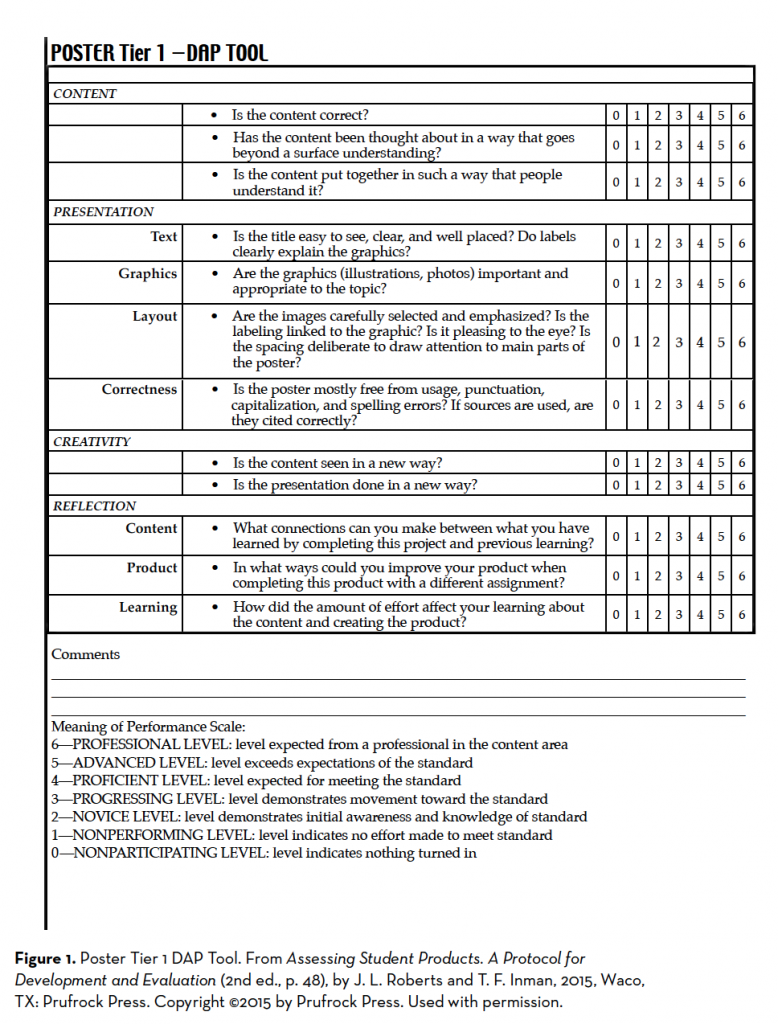
- Content: Whether according to state or national standards or an individual school’s curriculum, students attend school to learn. From the parts of the cell to the prediction of America’s future in a three-party system, that content must be accurate, presented coherently so the audience understands it, and go beyond a surface-level understanding. The product must be authentic in that it accurately reflects the learning that has occurred. After all, learning the content is usually the reason an assignment is made.
- Presentation: This section of the DAP Tool focuses on the product itself: the attributes inherent in it and what excellence looks like for each attributes. For example, if a student produces an exemplary model, it will make the viewers see the purpose of the model (whether symbolic and/or realistic). The model will clearly exhibit knowledge of a scale and use it appropriately. If it is a realistic representation, the scale will be measurable. If it is symbolic, the model may or may not follow a measurable scale and may communicate ideas by dramatically altering the scale or only scaling objects relative to one another. It will be constructed of materials that enhance the meaning of the model. As for labels, they will be clear and pertinent, match the key, and be free from punctuation, capitalization, or usage errors. If sources are used, they will be accurately referenced. Authentic products, those that are created in the real world, must mirror the industry’s standards if students are to be career ready. The presentation component is the only one of the four that is different for various products because what it takes to make an outstanding video will differ in every respect from what it takes to write an essay or produce a podcast.
- Creativity: All too often, the opportunity to develop creativity and creative thinking is sacrificed for a pacing guide or in response to not having time for creative work. If students are to be innovative, productive thinkers, then they need to develop these skills. Creativity simply is not the act of creating a painting, a poem, or a song. In the DAP Tool, creativity is assessed in two areas: the presentation (i.e., the product) and the content. So when students are creating the product, they cognitively assess the originality and innovation that go into their thinking about the content and also their creation of the product itself. They need to personalize both through their insight and creativity. Creative thinking engages students in thinking about the content from a different perspective—different from the one used when the content was introduced and developed. Creativity as one of the four components of the DAP Tool keeps the importance of creative thinking buoyant in the development of any and all products.
- Reflection: The last and perhaps the most telling of the four components, reflection focuses on content, presentation, and self as a learner. Students assess themselves as they analyze and evaluate connections to past learning and make predictions about connections to future learning. They analyze and evaluate product components in regard to past and future creations of the same product. Finally, they analyze themselves as learners, projecting how changes to the process might increase their capacity as learners. This component encourages not only metacognitive growth in the learner, but also student responsibility for learning. Unfortunately, most students have not experienced reflecting on their learning, so the DAP Tool provides prompts to encourage deep reflection and honest communication about that refection, as shown in Figure 2.
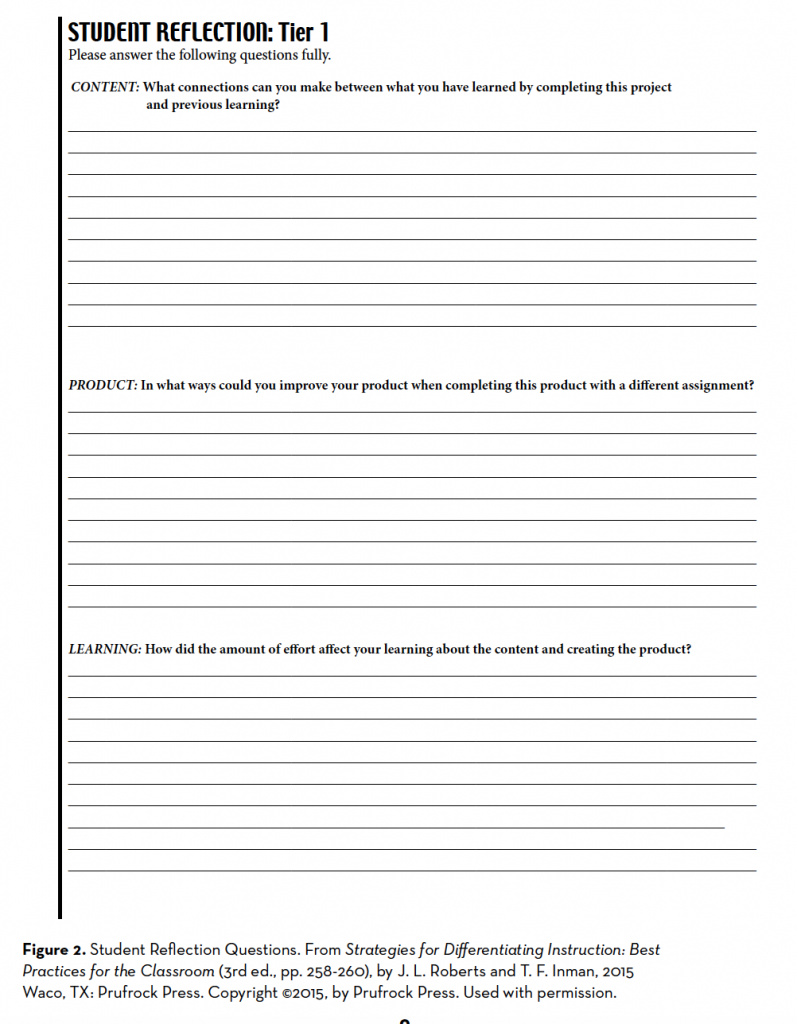
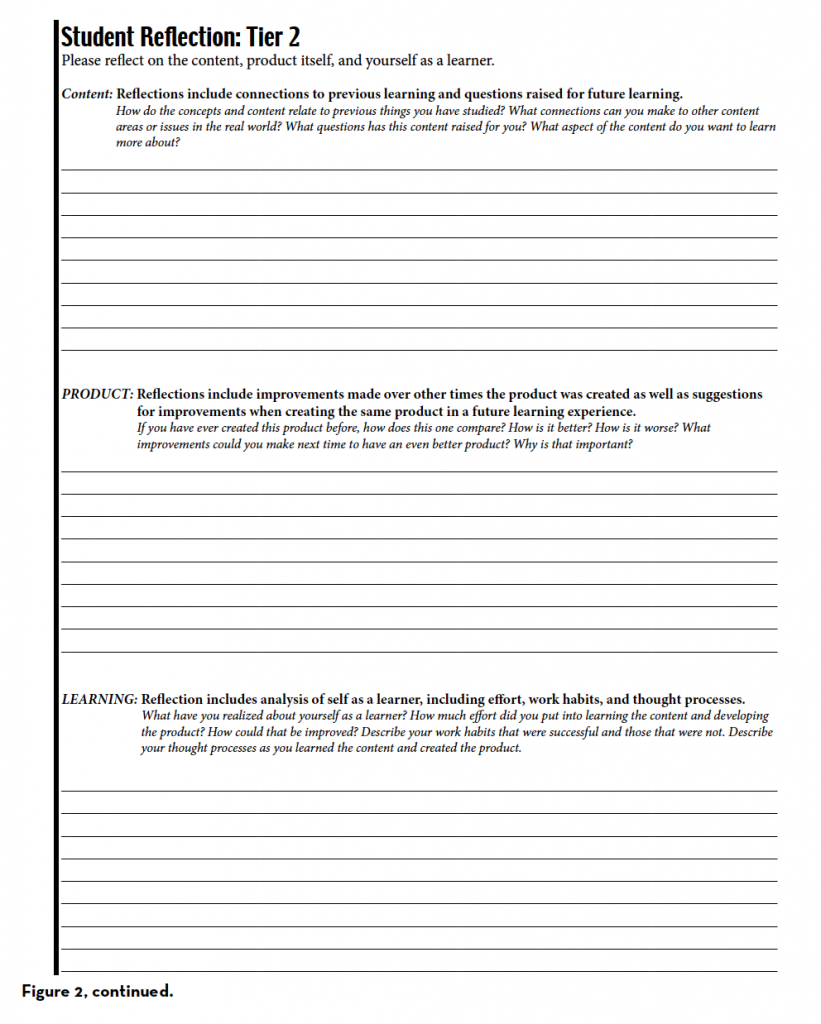
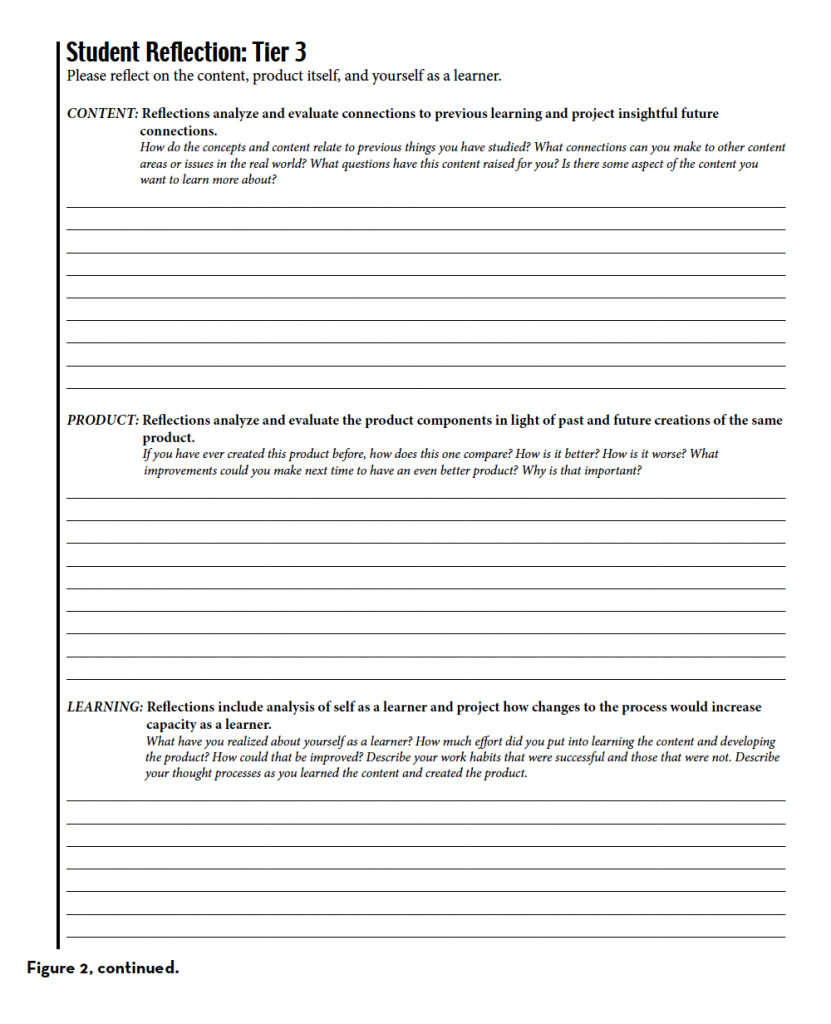
Three Tiers
Mentioned earlier regarding personalizing the learning, another innovation of the DAP Tool is that each product has three levels: Tier 1, Tier 2, and Tier 3. Each one has the same four components, grading scale, and product attributes in the presentation section. Each also resembles the other in appearance; however, each tier becomes more challenging with higher expectations. If students are to grow, they need appropriate levels of challenge. For accomplished speakers to only be expected to deliver monologues in the most basic form is an injustice and disrespectful of the speakers. They will only grow by pushing themselves (with support)—perhaps by focusing on the effective use of tone, varying their pace, and employing pauses to enhance the meaning and audience engagement. These tiers encourage differentiation of complexity for advanced learners or learners proficient at creating a certain product. The tiers also allow for schoolwide use of the DAP Tool, perhaps utilizing Tier 1 in lower grades and introducing other tiers when appropriate. Figures 3 and 4 outline the increased challenge with each tier.
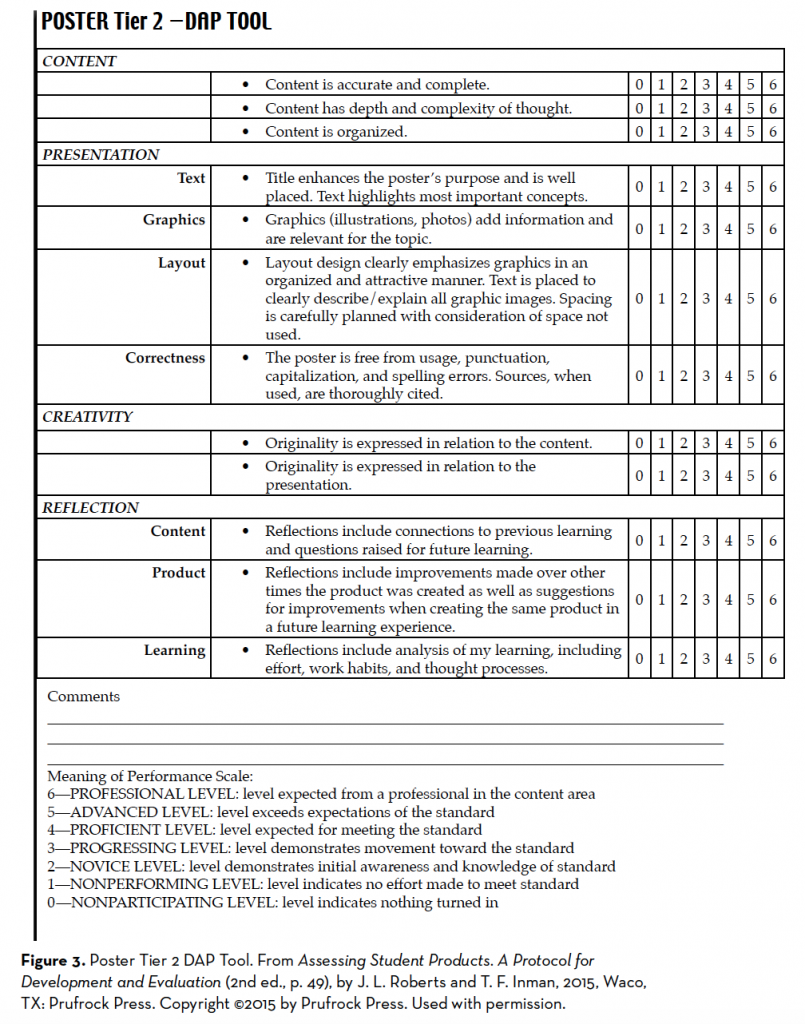
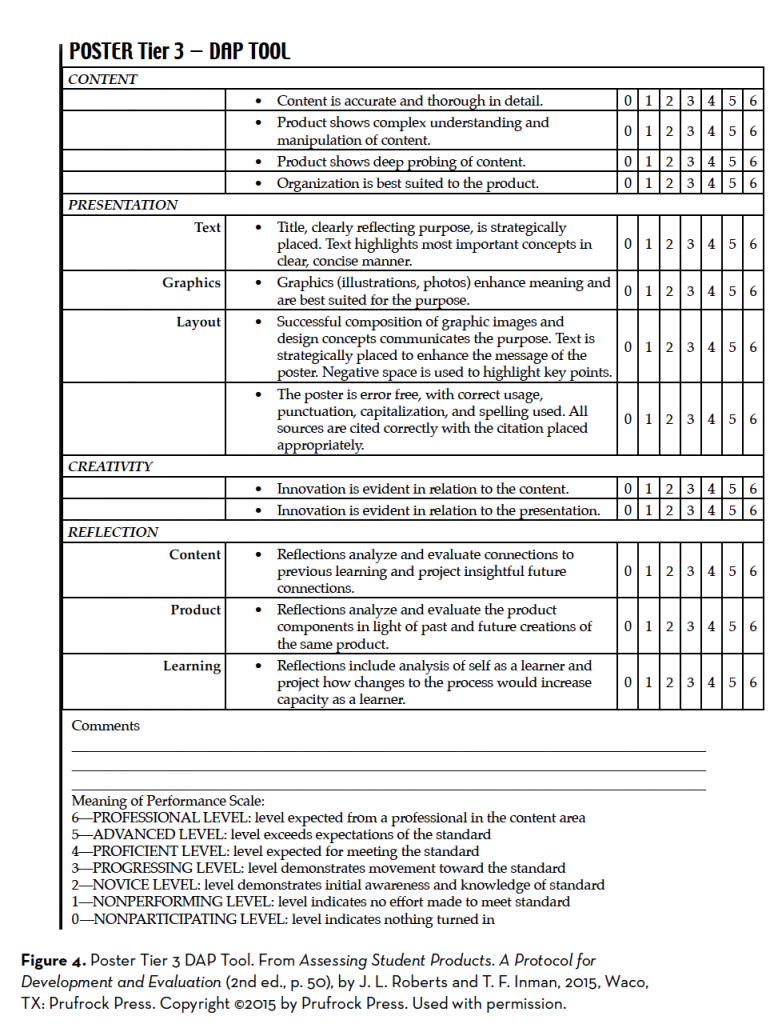
Grading Scale
An exciting innovation, especially for advanced learners, is the grading scale that removes the learning ceiling. All too often, these students aim for the highest grade or level on a rubric whether that is a letter grade, descriptor, or number. Oftentimes, too, effort equates to the minimum to accomplish that goal. Learners may not care about improvement when the grade is an A; they might not even realize that there is room for improvement! Having seven levels (i.e., nonparticipating, nonperforming, novice, progressing, proficient, advanced, and professional), the DAP Tool more accurately assesses mastery according to the standard. Moreover, by providing detailed description of the criteria, it provides the means for improvement especially when used in formative assessment. Please note that these levels do not correspond to specific grades. Because no one in the class is expected to be at the professional level, it should not equate to an A. Depending on the educator or school’s grading requirements, proficient could be the A. Use common sense when transferring the tool into a score because the grade ideally reflects the learning. Arter and Chappius (2006) believed that logic should prevail over percentages; Creating and Recognizing Quality Rubrics provides a detailed explanation of changing rubrics into grades. (See Roberts and Inman [2015a] for a discussion of multiple ways to transfer a DAP Tool to the grading book.)
Differentiated Learning
Differentiation is essential in classrooms in which all learners are making continuous progress. The DAP Tool frees teachers to offer product choices (i.e., differentiation of product.) Whether based on interest or learning profile, differentiation of product motivates learners as they demonstrate their learning in a preferred modality, favorite product, or exciting new product. The varying tiers encourages differentiation based on student experience with the product or content or student ability. If a student is more experienced with a particular product, the teacher can easily raise the tier (and thus the level of expectations) for that particular student on that specific assignment. Because each DAP Tool has three already-created tiers, the teacher does not need to design multiple rubrics in order to increase challenge for some learners. Figure 5 outlines the developed DAP Tools to date.
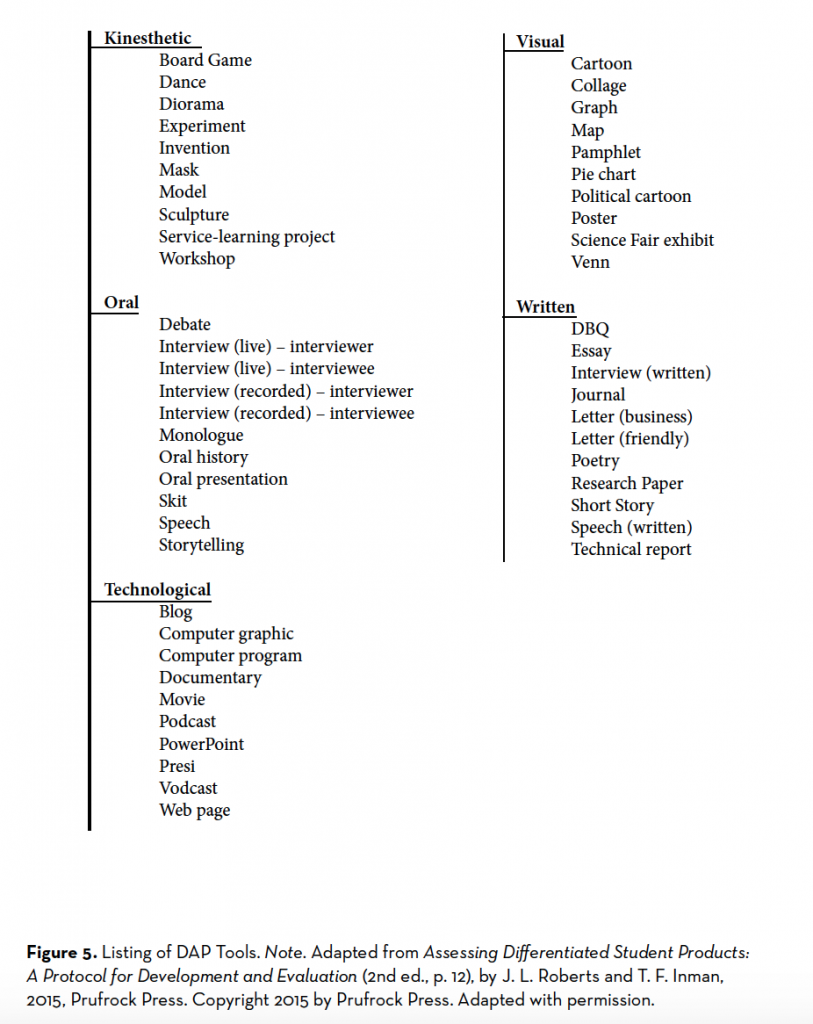
Final Thoughts
The DAP Tool offers a protocol that simplifies assessment, encourages differentiation, and removes the learning ceiling. Consistent with research, it encourages personalized learning that yields critical information regarding student growth. The importance of content is readily apparent with assignments, and, if used consistently, the repeated use of reflection becomes a life skill. In fact, the benefits to using a protocol to assist students in developing products as well as educators in assessing them are numerous:
- DAP Tools are appropriate to use in all content areas and across grade levels.
- Experts provided details on the presentation component of DAP Tool in order to ensure that the descriptions were true to what professionals. The purpose of consulting specialists was to ensure products meet authentic, 21st-century workplace demands.
- DAP Tools provide students with a reliable guide for developing products that address authentic industry standards.
- The variety of developed DAP Tools allows teachers to branch out from their typical product offerings to address student interests and develop their strengths.
- Students have more choice, as the DAP Tools have been developed for various products.
- The language for the components—content, creativity, and reflection—is the same for all tiers. Because presentation is the only component that changes, it stands out as the only component that needs to be taught, and that is only the case when students have not developed that product before. Teachers save valuable learning time due to the consistency of the language.
- The grading scale removes the learning ceiling, thus encouraging all students, especially those with gifts and talents, to work for continuous improvement and growth.
- Three tiers make it possible and defensible to differentiate assessment.
- The reflection component engages students in metacognitive thinking, promoting independence and responsibility for learning, and develops reflection as a life skill.
- A completed DAP Tool can serve as a preassessment in any or all of the four components (Inman & Roberts, 2015).
References
Arter, J. A., & Chappius, J. (2006). Creating and recognizing quality rubrics. Pearson.
Antonetti, J., & Stice, T. (2018). Powerful task design: Rigorous and engaging tasks to level up instruction. Corwin.
Beghetto, R. A. (2014). Creativity development and enhancement. In J. A. Plucker & C. M. Callahan (Eds.), Critical issues and practices in gifted education: What the research says (2nd ed., pp. 183–196). Prufrock Press.
Chappius, S., Stiggins, R. J., Arter, J., & Chappius, J. (2005). Assessment for learning: An action guide for school leaders. Educational Testing Service.
Frey, B. B., Schmitt, V. L., & Allen, J. P. (2012). Defining authentic classroom assessment. Practical Assessment, Research, and Evaluation, 17(2), 1–18.
Gray, L., & Ferrell, G. (2014). Feedback and feed forward: Using technology to support learner longitudinal development. http://www.jisc.ac.uk/guides/feedback-and-feed-forward
Inman, T. F., & Roberts, J. L. (2015). Promoting excellence and continuous progress with products. TEMPO, 36(1), 6–14.
National Association for Gifted Children. (2019). 2019 Pre-K–Grade 12 Gifted Programming Standards. http://www.nagc.org/sites/default/files/standards/Intro%202019%20Programming%20Standards.pdf
Renzulli, J., & Callahan, C. (2008). Assessing products. In J. VanTassel-Baska (Ed.), Alternative assessments with gifted and talented students (pp. 259–283). Prufrock Press.
Rimm, S. B., Siegle, D., & Davis, J. G. A. (2018). Education of the gifted and talented (7th ed.). Pearson.
Roberts, J. L., & Inman, T. F. (2015a). Assessing differentiated student products: A protocol for development and evaluation (2nd ed.). Prufrock Press.
Roberts, J. L., & Inman, T. F. (2015b). Strategies for differentiating instruction: Best practices in the classroom (3rd ed.). Prufrock Press.
Shepard, L., Hammerness, K., Darling-Hammond, L., & Rust, F. (with Snowden, J. B., Gordon, E., Gutierrez, C., & Pacheco, A.). (2005). Assessment. In L. Darling-Hammond & J. Bransford (Eds.), Preparing teachers for a changing world: What teachers should learn and be able to do (pp. 275–326). Jossey-Bass.
Tomlinson, C. A. (2014). Differentiated instruction. In J. A. Plucker & C. M. Callahan (Eds.), Critical issues and practices in gifted education: What the research says (2nd ed., pp. 197–210). Prufrock Press.
Tomlinson, C. A., & Moon, T. R. (2013). Assessment and student success in a differentiated classroom. ASCD.
VanTassel-Baska, J. (2018). Considerations in curriculum for gifted studies. In S. I. Pfeiffer, M. Foley Nicpon, & Shaunessy-Dedrick (Eds.), APA handbook of giftedness and talent (pp. 349–370). American Psychological Association.
VanTassel-Baska, J., & Baska, A. (2019). Curriculum planning and instructional design for gifted learners (3rd ed.). Prufrock Press.
Vygotsky, L. S. (1978). Mind in society: The development of higher psychological processes. Harvard University Press.
Julia Link Roberts is the Mahurin Professor of Gifted Studies and the Executive Director of The Center for Gifted Studies at Western Kentucky University and The Gatton Academy of Mathematics and Science in Kentucky. Dr. Roberts is President of the World Council for Gifted and Talented Children, Chair of the Kentucky Advisory Council for Gifted Education, and member of the boards of The Association for Gifted Education and the Kentucky Association for Gifted Education. She is author and presenter on advocacy, policy, differentiation, and gifted education.
Tracy Inman, Ed.D., NAGC Board parent representative, is Associate Director of The Center for Gifted Studies at Western Kentucky University. Tracy has presented on the state, national, and international levels; trained thousands of teachers in differentiation and gifted education; published multiple articles and books including four TAGT Legacy Award winners, and worked with thousands of parents.



